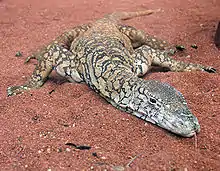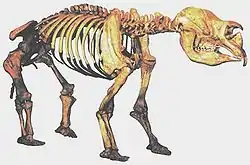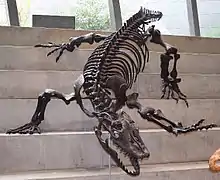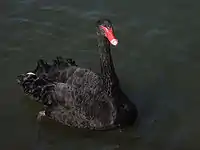澳洲巨型動物群
澳洲巨型動物群是一些澳洲的大型動物,一般體重在30公斤以上,或比其現存親屬重30%以上。大部份澳洲巨型動物群都已於更新世滅絕。[1]
澳洲巨型動物群滅絕的成因現正研究中。有指是因人類約於4.8-6萬年前的到來,獵殺及使用火來管理環境所致。[2]於1.8萬年前最高峰的冰期令環境乾旱可能也是成因之一。不過澳洲巨型動物群在突然消失前,已經生存了達200萬年,期間也有出現乾旱的冰期。根據光釋測年及鈾-釷測年的最新證據,人類可能就是澳洲巨型動物群滅絕的主因。[3]所有形式的巨型動物群都是於同一時期(約於4.7萬年前)內滅絕,正好人類首次到達澳洲。從巨型動物群牙齒的氧及碳同位素分析,顯示一場突然及大型的非氣候事件,改變了植被及現今有袋類的食性,且令巨型動物群滅絕。研究進一步發現當時的氣候與今天的乾旱情況無異。
史前的澳洲巨型動物群與一些傳說生物有很多相似的地方。
1788年前滅絕的巨型動物群
單孔目
1000-2000公斤[5]
100-1000公斤
- Euowenia grata:歐氏獸的一種。
- Nototherium mitchelli:南袋獸屬的一種。
- 寬顴弓獸(Euryzygoma dunense)
- Phascolonus gigas:大袋熊屬的一種。
- Ramsayia magna:拉氏袋熊的一種。
- Procoptodon goliah:巨型短面袋鼠的一種,是最大的袋鼠,高2-3米及重230公斤。
- Procoptodon rapha、P. pusio及P. texasensis:巨型短面袋鼠下的物種。
- 平面袋鼠:是一屬巨型的沙袋鼠。[6]
- Palorchestes parvus:袋貘的一種。
- Macropus pearsoni及M. ferragus:大袋鼠屬的物種。
10-100公斤
- Simosthenurus pales:短鼻粗尾袋鼠屬的一種。
- 丁氏強袋鼠、Sthenurus oreas、S. andersoni及S. atlas
- 巨型樹袋熊:比現今的樹熊大上三分之一。
- Phascolomys medius
- Lasiorhinus angustioens:毛鼻袋熊屬的一種。
- 和諧袋鼠
- Troposodon minor:褶齒袋鼠屬的一種。
- 小型短臉袋鼠:與現今的東部灰大袋鼠一樣高,但較為粗壯。
- Simothenurus brownei、S. gilli及S. maddocki
- 食肉袋鼠:生存於中新世及上新世,重達70公斤,高1.5-3米。牠們的牙齒顯示是肉食性的。
- 劊子手袋獅:大小如豹。
- Vombatus hacketti:袋熊屬的一種。
- Macropus thor、M. piltonensis及M. rama:大袋鼠屬的物種。
- Warrendja wakefieldi
- Sarcophilus harrisii laniarius:袋獾屬的一種,外觀像放大了袋獾。
鳥類

史氏雷嘯鳥。
1788年後滅絕的物種
參考
- Josephine Flood. . Marleston: J.B Publishing. 2004: 182. ISBN 1876622504.
- Miller, G. H. . Science. 2005, 309: 287–90. PMID 16002615.
- Prideaux, G.J.; 等. . Nature. 2007, 445: 422–5.
- L.K. Corbett. (PDF). [2009-10-05]. (原始内容 (PDF)存档于2008-05-28).
- Flannery. T Pleistocene extinctions as cited in Josephine Flood (2004) Archaeology of the Dreamtime, J.B Publishing, Marleston p. 178 ISBN 1-876-62250-4
- Helgen, K.M., Wells, R.T., Kear, B.P., Gerdtz, W.R., and Flannery, T.F. . Australian Journal of Zoology. 2006, 54: 293–303. doi:10.1071/ZO05077.
- Molnar, R. . Indiana University Press. 2004: 127.
- Scanlon JD and Mackness BS. . Alcheringa. 2001, 25: 425–37.
- Field, J. H. and J. Dodson. 1999. Late Pleistocene megafauna and archaeology from Cuddie Springs, south-eastern Australia. Proceedings of the Prehistoric Society 65: 1-27.
- Field, J. H. and W. E. Boles. 1998. Genyornis newtoni and Dromaius novaehollandiae at 30,000 b.p. in central northern New South Wales. Alcheringa 22: 177-188.
- Long, J.A., Archer, M. Flannery, T.F. & Hand, S. 2003. Prehistoric Mammals of Australia and New Guinea -100 Million Years of Evolution. Johns Hopkins University Press, Baltimore. 242pp.
- Murray, P. F. and D. Megirian. 1998. The skull of dromornithid birds: anatomical evidence for their relationship to Anseriformes (Dromornithidae, Anseriformes). Records of the South Australian Museum 31: 51-97.
- Roberts, R. G., T. F. Flannery, L. A. Ayliffe, H. Yoshida, J. M. Olley, G. J. Prideaux, G. M. Laslett, A. Baynes, M. A. Smith, R. Jones, and B. L. Smith. 2001. New ages for the last Australian megafauna: continent-wide extinction about 46,000 years ago. Science 292: 1888-1892.
- Wroe, S., J. Field, and R. Fullagar. 2002. Lost giants. Nature Australia 27(5): 54-61.
- Gavin J Prideaux, Richard G. Roberts, Dirk Megirian, Kira E. Westaway, John C. Hellstrom, John M. Olley. 2007. Mammalian responses to Pleistocene climate change in southeastern Australia. Geology, v. 35, n. 1, p. 33-36.
外部連結
This article is issued from Wikipedia. The text is licensed under Creative Commons - Attribution - Sharealike. Additional terms may apply for the media files.







